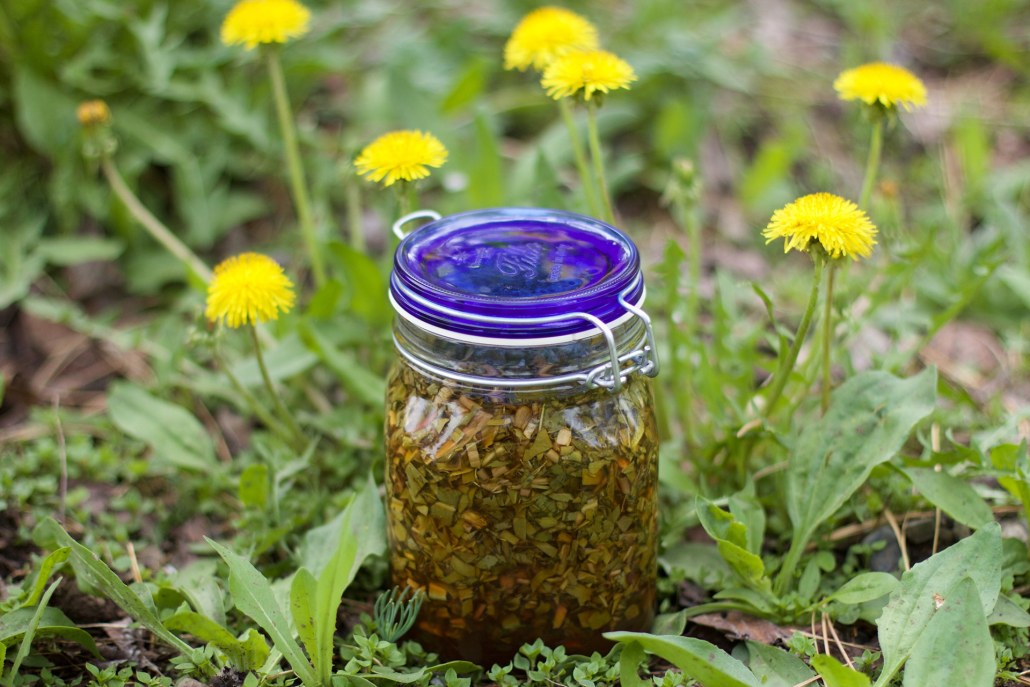
How to Make Herbal Vinegars
Spring is popping up everywhere! Each morning I wake up to birdsong and then head outside to see who’s emerging. I live in a northern climate (zone 4), which means that spring starts slowly and a bit later than most. That’s okay, I treasure each new plant, watching it unfurl day by day!
My friend Rebecca Altman, from Wonder Botanica, recently wrote about her spring tradition of making a multi-plant, mineral-rich herbal vinegar. As a lover of simples, my herbal vinegars tend to be made with a single plant. Dandelion vinegar, nettle vinegar, and so on. But as soon as I read about this, I knew I wanted to make my own spring greens vinegar.
Why vinegar?
Vinegar excels at extracting minerals from plants. Minerals, like calcium, magnesium, and phosphorous, are important for building strong bones, teeth, and hair, but they can be hard to extract. Alcohol doesn’t extract them and water can, but you need to simmer the herbs or infuse them at high heat for an extended period of time.
For this recipe, I’m using organic apple cider vinegar. Infused herbal vinegars can be taken daily by the teaspoonful as a mineral tonic, or used in salad dressings or cooking greens (which is what I like to do).
Before I get to the herbal vinegar recipe, follow me outside to see what there is to harvest. I’ll invite my husband along, too, so I can take photos of him harvesting the plants.
Stinging Nettle (Urtica dioica)
First stop is the garden.
Yes, I planted stinging nettle in my garden. No, I’m not insane.
I live in a dry climate, and although nettles grow here and there, I knew the best way for me to use them frequently was to put them near me! Right now I have just this one patch, but we have immediate plans to put in another one… but that’s another story entirely.
These are at the perfect stage for harvesting. Wearing gloves to avoid the stings, we’ll use scissors to clip the stems just above the leaf node. Nettles will continue to grow and I’ll get multiple harvests throughout the spring and early summer.
Nettles are very high in minerals, especially those bone-building minerals I mentioned earlier. I often say that a side effect of using nettles regularly is luxurious hair and strong teeth and bones. Eating lightly cooked nettles (you need to cook them to get rid of the sting) is another way to enjoy the benefits of this nutrient-dense plant.
Dandelion (Taraxacum officinale)
My home is a dandelion haven and right now we are in full swing of the spring bloom. This is one of my favorite times of year! Those golden orbs fill the lawn with their cheery color and the bees are happily collecting their pollen. Dandelion leaves and roots are high in minerals like potassium and calcium. They also both contain inulin, an important prebiotic that can support healthy gut flora.
Digging dandelions out of the lawn isn’t the easiest task. Luckily I have several growing in my raised garden beds and I’d like to remove them to make room for my vegetable starts. To do this, we’ll use my hori hori knife to dig into the soil and loosen it enough to pop out the entire root. If I leave even a bit of root behind, the dandelion will continue to grow – which is fine for me. They are easy to harvest and have so many benefits!
For this herbal vinegar, I will use the whole flowering plant with the exception of the dandelion flower stem, which is filled with a bitter sap.
Plantain (Plantago major, P. lanceolata)
I am so lucky to have so much plantain growing all over my garden. From spring to fall I have fresh leaves readily available for any first aid needs like insect bites or cuts and I can easily dry plenty for teas. We have bee hives and they go nuts when the plantains are in flower; it feels like the whole garden is vibrating with their buzz. I never realized such a small flower could inspire so many bees!
Plantain is, you guessed it, high in minerals. While you can eat the very young leaves, they soon become tough and unpalatable (although blanching them helps). Infusing them in herbal vinegars is a quick and easy way to enjoy their goodness.
To harvest, we’ll just be picking leaves from here and there from healthy sized plants. While a lot of the plantain in my garden gets trampled underfoot, I keep several sections free from human traffic so I can avoid harvesting plants that have been walked on.
Alfalfa (Medicago sativa)
We have oodles of alfalfa growing all over our property. I’m guessing somewhere down the line previous stewards planted it as a crop. This tenacious plant has deep taproots that help it thrive in dry environments; it also makes it fairly impossible to remove! With regular watering, it grows fast. It can be cut down to the ground and it will continue to grow for three to four cuttings throughout the growing season. I’ve been told that chickens love it, but our chickens never got that memo.
Alfalfa can be dried and used in teas. It’s high in potassium, calcium, phosphorous, and magnesium.
To harvest alfalfa, we’ll use a sickle, or curved knife (pictured above) to slice down a handful.
Violets (Viola spp.)
Last year I planted lots of violets in my garden and lawn and they are slowly starting to spread. I dream of one day having violets everywhere! Those gorgeous little flowers are fun to make remedies with and the leaves are a lovely soothing mucilaginous plant that is perfect to address hot and dry tissues.
Most of the violets have already done their major flowering for the season, but for this herbal vinegar, I’ll add some of those leaves. We’ll collect a few leaves from several different plants so I don’t put too much stress on any individual. Violet flower vinegar turns a gorgeous color… but that is for another article.
Other Spring Green Ideas
Other spring plants that would make great herbal vinegars include lamb’s quarters (Chenopodium album), purslane (Portulaca oleracea), chickweed (Stellaria media), and cleavers (Galium aparine). I know I must be forgetting some, too. Basically any edible plant that is high in minerals is a good choice here. All the plants listed in this article are safe to use; however, always be certain that you have correctly identified the plant.
Tips for Prepping Your Herbs
Before I head inside, I’ll shake the plants a bit to dislodge any creatures. I’ll give the dandelion flowers a gentle but persistent shake as there are little bugs that like to crawl deep into the flower head. I’ll wash the dandelion root and some of the plantain leaves as they have some dirt on them, but otherwise there’s no need to wash the other herbs.
Once everything is prepped, I’ll mince everything as finely as possible. This both increases the surface area of the plant, which makes it easier to extract, and allows for me to fit a lot in a jar. One of the most common mistakes I see with beginning herbal remedy makers is that they don’t chop their herbs, which makes for a more diluted remedy.
Spring Greens Herbal Vinegar
Herbal vinegars are an excellent way to extract minerals from our fresh spring greens. They can be taken as a mineral boost by the spoonful or used in salad dressings or cooked greens. The optional blackstrap molasses adds more nutrients and gives this a slightly sweet taste. If you want to make this recipe and don’t have access to fresh greens, then use a similar combination of dried mineral-rich herbs, but only fill the jar halfway.
What you’ll need…
- Several handfuls of fresh edible spring greens including dandelion leaves and roots, stinging nettle leaves, alfalfa leaves, plantain leaves, violet leaves, etc.
- 2 tablespoons blackstrap molasses (optional)
- Approximately 3 cups apple cider vinegar (at least 5% acidity)
- Gather your greens, gently remove any bugs to relocate them to a new home, and then wash the greens, if necessary, to dislodge any dirt or debris.
- Chop the herbs finely and place them in a quart or liter-sized glass jar. You want them to snugly fill the jar without being too loose or too crammed in there.
- Add the blackstrap molasses, if using.
- Then, pour apple cider vinegar over the herbs until the jar is filled. Cover with a glass or plastic lid. If you don’t have these, then use parchment paper as a barrier between the vinegar and a metal lid (vinegar will corrode metal and ruin your batch).
- Shake well. Keep this on your counter for 2 to 4 weeks, shaking daily. When you’re ready, strain off and reserve the vinegar. Compost the plants.
- This is best stored in the fridge for a longer shelf life, but it can also be kept on the counter. Shelf life is anywhere from 6 months to a year.
Yield: 2 1/2 cups
Now I’d love to hear from you!
How do you like to enjoy spring greens?
What herbs do you like to make into herbal vinegars?
Please share in the comments below.


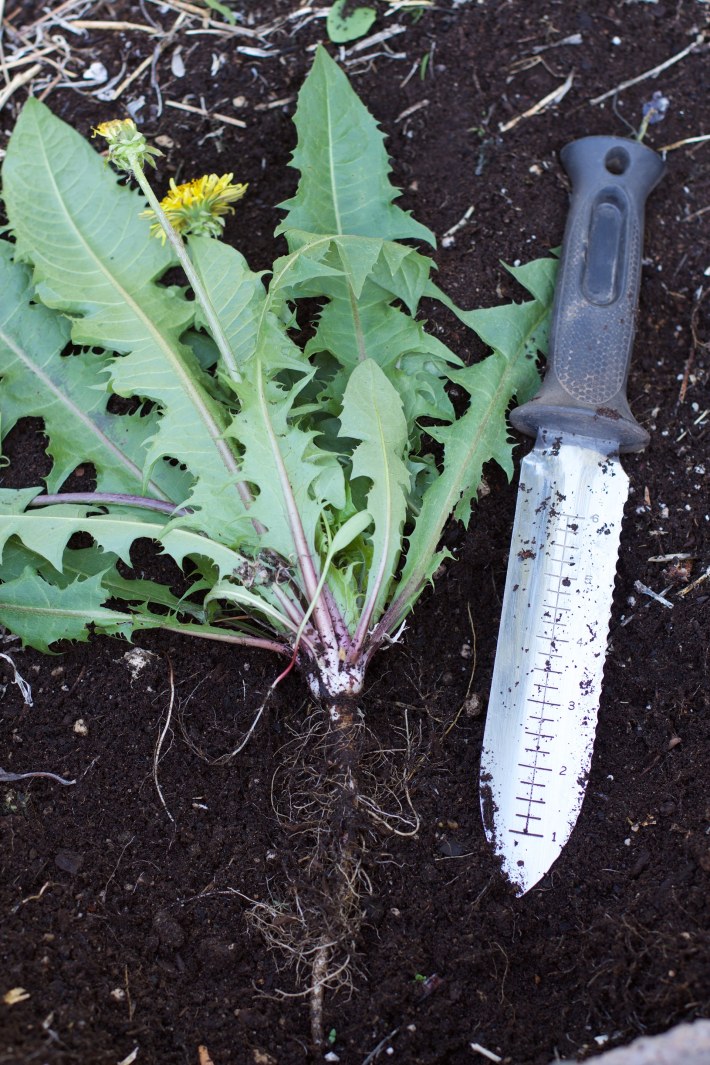




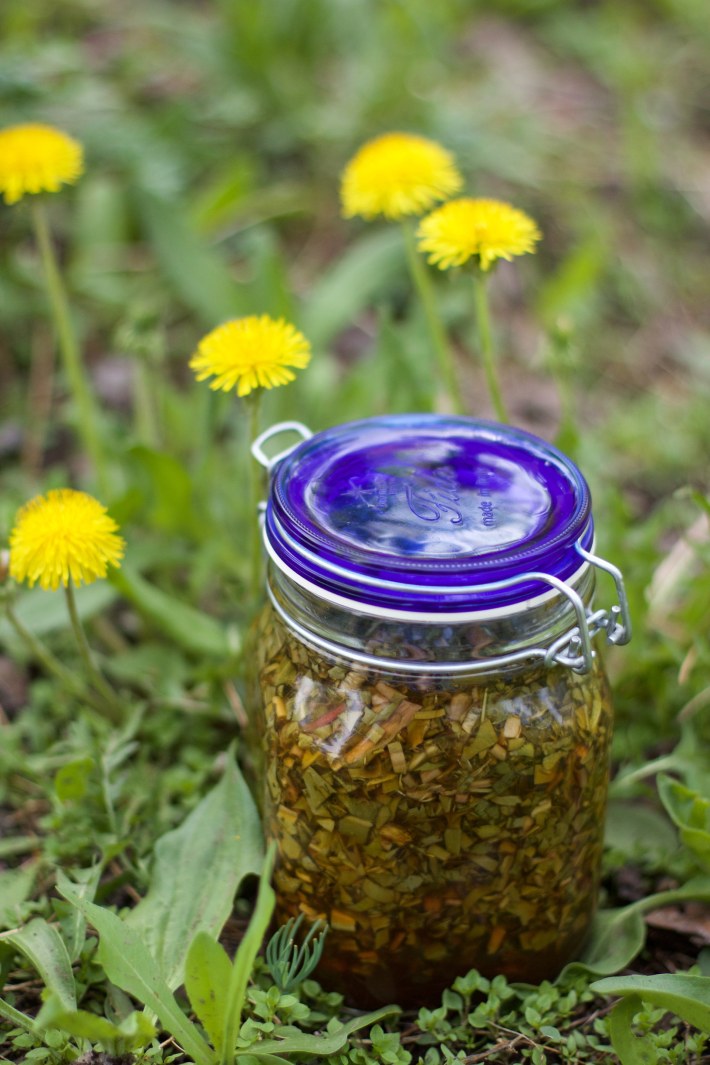

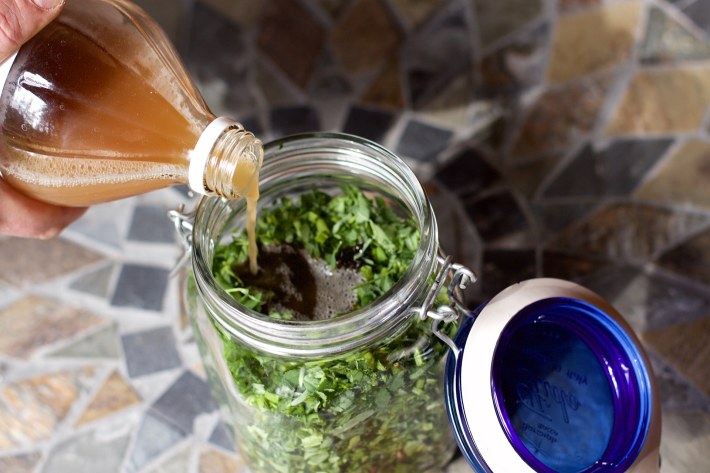

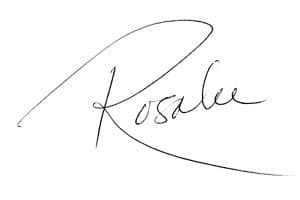






These are great I would love more
Great, we have more on our site here! When I used the search bar with the orange magnifying glass, at least half a dozen “vinegar” recipes came up. Enjoy!
Recently someone I know made an herbal vinegar with nettles and she had a reaction to the nettle which swelled up her throat and eyes. I am not sure how long she let the herbs soak in the vinegar, but should nettles be in the vinegar a certain length of time before they loose their sting?
Ouch! Has she ever had stinging nettles before? This sounds like an allergic response.
J’ai déjà lu (dans un livre, je crois) qu,une herboriste ajoute des coquilles d’oeufs biologiques et bien lavés dans la macération afin d’ajouter encore plus de calcium.
Oui! On peut faire ça aussi!
What is the blackstrap molasses for?
The optional blackstrap molasses adds more nutrients and gives this a slightly sweet taste.
Thank you so much!
1) Can this take the place of mineral suppliments?? Meaning does this cover all of the minerals our body needs??
2) If I added a dropper of Fulvic Acid, what would the vinegar do to this? Would it make it stronger?
This recipe is a wonderful addition to your diet, however it’s not meant to be stand alone supplement. While it’s undoubtedly high in minerals, without lab testing your particular batch, we couldn’t say exactly what or how much is in there. The best source of minerals is a diverse and nutrient rich diet.
Would you be able to do this with dried herbs as well?
Yes, absolutely! My fresh spring greens are long gone here in San Diego. Use half the amount of herbs when they are dried. If they are not already cut and sifted, then I’d use a mortar and pestle or something to chop them up a bit. Enjoy!
This is not so much making vinegar as it is a vinegar Infusion… Correct?
Yes, it is an herb-infused vinegar.
Hi, thank you for such a great herbal vinegar recipe. I would like to ask, since I don’t get on too well with apple cider vinegar, would it be ok to make this recipe using white wine vinegar instead?
In herbalism, most people use apple cider vinegar. I would try it with other vinegars in your case. Experimenting with smaller amounts might be a good idea, too.
Do you still only use the young Plantain leaves for the herbal vinegar or may the older leaves also be used?
Chewing the older plantain leaves is tough. It’s okay to use any age leaf in this preparation.
Thanks!
Hello there!
Would this be something a pregnant or breastfeeding woman can use?
Thank you for the great articles!
In general, vinegar and these specific herbs and blackstrap molasses are all foods. They can be consumed in ordinary food quantities by most people. There are plenty of herbs that are contraindicated for pregnant and breastfeeding women, so you’ll want to check each herb. I checked these exact herbs and they are okay. Enjoy!
For those of us who live n the city, can we use dried herbs to make the vinegrs? Would the taste, nutrient value be any different?
Yes, absolutely! My fresh spring greens are long gone here in San Diego. Use half the amount of herbs when they are dried. If they are not already cut and sifted, then I’d use a mortar and pestle or something to chop them up. The taste and nutrients will be comparable. Enjoy!
Sweet Rosalee, you made my heart sing when you said you returned the little bugs to the garden. Much love from Australia and thank you so much for a fantastic article. A non-vegan friend asks if it’s possible to use raw honey instead of molasses – she has her own hives on an organic veggie farm.
The optional blackstrap molasses adds more nutrients and gives this a slightly sweet taste. When you add honey, the effect will be different. You certainly can and then it is called an oxymel. Enjoy!
Thanks for sharing this timely recipe, Rosalee! I made it today and also included lambs quarters, since they were growing right next to the plantain. I used a trick from sauerkraut making to keep the herbs submerged – put some water in a little zip lock baggie and place it on top of the herbs and vinegar. It also makes an air tight seal.
Love this! Thank you! I too grow nettles in my garden. Yes, everyone thinks I’m weird. Cannot wait to try this.
I got some Nettles from my neighbor to plant in my herb garden. She and I exchange herbs and plants so we both get more free stuff. Love that others are growing their own as well.
Reading this article made my heart smile. The beautiful weeds in vinegar. Perfect! Can we use it like any other vinegar, generously on our plates at almost every meal? I use vinegar on e.v.e.r.y.thing lol
Or is it more medicinal in concentration and we stick to a tbsp a day like a tonic?
Love all these herb sisters you suggest to infuse!
It will be a wonderful addition to your diet! The herbal “weeds” typically have more general nutrition constituents versus strong medicinal constituents. I’d play around with it and see how your body responds. Enjoy!
I have a few large leaf Plantain. But I also have a gazillion small Plantain. Are the small ones usable too?
I haven’t used plantain in herb vinegar before, but I’ve been using it to make salves for many years and my understanding is that ALL varieties of plantain are usable in the same manner.
There are about 200 species worldwide, with about 30 native and 5 introduced species in the US. The ones we tend to use most in herbal medicine are Plantago major, P. lanceolata, P. rugelii, P. rhodosperma, and P. virginica. From my reading and understanding, they can all be used interchangeably as long as you know for sure it is indeed plantain (of course).
I make a herb vinegar with everything I can find. Whatever is growing in the garden at the time. Dandelion, plantain, asparagus ends in season, borage leaves and flowers, yarrow, calendula, you get the gist, whatever is growing. Each batch is different obviously but the vinegar makes the most delicious salad dressing. Thankyou for saying to cut the herbs up as I just squish them into the jar. I will certainly do that next time.
I usually eat all those “weeds” either fresh in a salad or dried as a mixed greens powder added to anything, from burgers to soups. Also save some dried for tea. Violet leaves are a first for me this year and stinging nettles don’t seem to want to grow for me, but I keep trying! I have been making goldenrod infused vinegar. I also make vinegars with all kinds of flower heads for my hair care. Now I must do some greens before I chop them all back to make room for planting! What a great idea!!!!
Sounds like a fabulous idea, Mama G!
I am remembering reading eons ago that the Native peoples called Plantain “The White Man’s Foot Print”. Apparently it is not a native plant & was introduced (probably by accident) by the European settlers.
I make Dandelion Jelly. I would use it in other recipes but MOH does most of the cooking and it’s an uphill struggle to get him to use anything other than “conventional” veg.
I dry nettles and use them in a tea or sprinkled on my cereal. I also sprinkle some on the dogs meal to help with his arthritis.
would use a lot more herbs and wild foods but, as I’ve said, it’s an uphill struggle, but I’m getting there – slowly
Why blackstrap molasses? The iron in it? Or??
The optional blackstrap molasses adds more nutrients and gives this a slightly sweet taste.
Why do you put the blackstrap molasse in the beginning ? Is it usefull to extract some nutrients ? I would mix it with the filtered vinegar at the end of the process (no waste because it sticks to the herbs).
You could probably do it either way. I liked the synergy of everything melding together during the extraction time. The blackstrap molasses didn’t stick to the herbs in my batch. The vinegar kept everything flowing. Maybe try it both ways and see what you like best.
Thank you for this great recipe! Have enjoyed previous herb vinegar recipes by Rosalee!
A thought about the herbs after Infusing ! With strong herb infusions in water, or with tinctures, the herbs are sieved out and put to compost, then the Infusion is decanted, isn’t it? But with the vinegar do the herbs stay in the vinegar for consumption?! Thank you for reassuring!
C
In this recipe, Rosalee recommends: when you’re ready, strain off and reserve the vinegar. Compost the plants.
For fresh plants, like this recipe, I would strain and remove the plant material. If you were to make a different herbal vinegar with dried plant material, you may want to leave the herbs. I base it off how appetizing the herbs look. Sometimes, it may make sense to strain and compost the herbs and then add new dried herbs for a more appetizing approach. Play around with it and see what you enjoy!
You say the nettles have to be cooked to remove their sting, but you don’t mention cooking in the recipe. Do you cook the nettles or not? Thank you!
Hi, could you use daisies (bellies perennis) in the same way. I have a lot of it on my lawn. Have dried most of what I collected. I don’t know what to do with the rest of it. At the moment I have frozen them as I am only just beginning to learn these things.
Hi rose I will definitely try this vinegar supplement and share my results great suggestion
Dandelions are my favorite with a close second being my marigolds!!! Thank you for sharing this and being an inspiration to me!!
Hi, what about making this kind of vinegar with horsetail? Do you think it would be interesting for bones, hair and nails issues?
Hi, can I use local honey instead of the molasse syrup ?